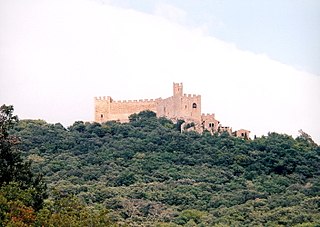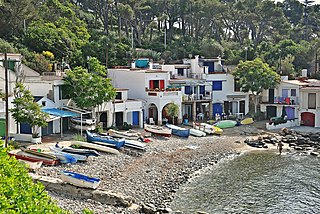
La Jonquera is a municipality in the comarca of l'Alt Empordà, in Catalonia, Spain. It is situated next to the border with Northern Catalonia, nowadays France, opposite the municipality of Le Perthus.

Baix Empordà is a comarca (county) in the Girona region, Catalonia, in Spain. It is one of the two comarques into which Empordà was divided in the comarcal division of 1936, the other one being Alt Empordà. It is popularly known as L'Empordanet. The capital is La Bisbal d'Empordà.

Empordà is a natural and historical region of Catalonia, Spain, divided since 1936 into two comarques, Alt Empordà and Baix Empordà.

The Costa Brava is a coastal region of Catalonia in northeastern Spain. Sources differ on the exact definition of the Costa Brava. Usually it can be regarded as stretching from the town of Blanes, 60 km (37 mi) northeast of Barcelona, to the French border – in other words it consists of the coast of the province of Girona.

L'Escala is a municipality in the comarca of the Alt Empordà in Girona, Catalonia, Spain. It is situated on the Costa Brava, located between the southern end of the Gulf of Roses and Cala (bay) Montgó. It is an important fishing port and tourist centre, and has a festival dedicated to its famous anchovies. The GE-513 road runs inland from the town.

Sant Llorenç de la Muga is a municipality in the Alt Empordà comarca, in the Province of Girona, Catalonia, Spain with an area of 32.06 km2 and a population of 177 people.

La Bisbal d'Empordà is the county seat of the comarca of Baix Empordà in Catalonia, Spain. The town lies 29 km southeast of Girona, 12 km west of Palafrugell and 19 km northwest of Palamós along road C-66 from Girona to Palafrugell/Palamós, where it becomes C-31. Two other roads branch off at La Bisbal, GI-660 to Calonge and Sant Feliu de Guíxols and GI-664 to Cassà de la Selva; both roads cross the hilly coastal range called the Gavarres, with many twists and turns. The municipality lies on the northern edge of the Gavarres, on either side of the Daró river-bed, a dry tributary of River Ter.

Sant Sadurní d'Anoia is a municipality in the comarca of the Alt Penedès in Catalonia, Spain; and the centre of production of a sparkling wine known as cava. It is situated in the north-east of the Penedès Depression at the confluence of the Avernó river and the Anoia river. It is accessible by the AP-7 autopista and the Renfe railway line (R4) that connect Barcelona with Manresa and El Vendrell.

Calonge is a municipality in the comarca of the Baix Empordà in Catalonia, Spain, on the coastline of the Costa Brava.

Sant Feliu de Guíxols is a municipality in the comarca of the Baix Empordà in Catalonia, Spain. It is situated on the Costa Brava and is an important port and tourist centre. The district abuts to the north, the upmarket s'Agaró resort built round the Sant Pol Beach. In addition to tourism and the port the cork industry is a traditionally local industry. The town contains a large monastery which now houses the town museum and is a protected historico-artistic monument.

Castell d'Aro, Platja d'Aroi S'Agaró is a municipality in the middle of the Costa Brava in Catalonia, Spain. It is formed from two parts: Castell d'Aro is an ancient village built around a medieval castle and a fortified church, 3 km inland on the road from Platja d'Aro to Santa Cristina d'Aro; and Platja d'Aro is a coastal town on the road from Palamós to Sant Feliu de Guíxols which stretches along a large 2 km beach. generally Castell-Platja d'Aro's population is about 12,000 but can exceed 100,000 in summer months.

Santa Cristina d'Aro is a small town in the Aro river valley at the junction of the road from Girona/Barcelona to Sant Feliu de Guíxols and Palamós. It is home to a number of workers in the nearby holiday resorts. The Costa Brava golf course is on the outskirts of the town.

Monells is a village belonging to the municipality of Cruïlles, Monells i Sant Sadurní de l'Heura in the comarca of the Baix Empordà. It is crossed by the Rissec river.

Cruïlles, Monells i Sant Sadurní de l'Heura is a Spanish municipality of the Province of Girona, situated in the comarca (county) of Baix Empordà (Catalonia), formed in 1973 by merging the municipalities of Cruïlles, Monells, and Sant Sadurní de l'Heura. Sant Sadurní is the capital of the municipality. According to the 2014 census, the municipality has a population of 1,284 inhabitants.
The Free Catalan Territory are those declared municipalities or regions of Catalonia that had approved a motion in a plenary session by the councillors of the town or the region council, as they represent the municipality's local authority. Such motions declare that Spanish laws and regulations are considered provisional, waiting for the Government and Parliament of Catalonia to enact new Catalan laws after having assumed national sovereignty, and therefore turning Catalonia into an independent state.

Sant Miquel de Cruïlles is a Benedictine monastery in Cruïlles, Monells i Sant Sadurní de l'Heura, Catalonia, Spain. The 11th-century building, in First Romanesque style, was declared a Bien de Interés Cultural landmark in 1931.
Sant Sadurní may refer to:
Sant Miquel may refer to:
The Toy Museum is located in the middle of the municipality of Sant Feliu de Guíxols, in the Baix Empordà region of Spain, and contains more than 6,500 pieces collected by Tomàs Pla, dated between the years 1870 and 1980, most of which were made in Spain.

The Cala s'Alguer is a traditional fishing village on the Costa Brava coast of Catalonia, Spain. It is part of the municipality of Palamós, in the comarca of Baix Empordà and the province of Girona. The historical complex has been declared a cultural asset of national interest.



















